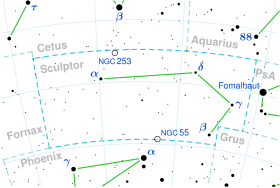Epsilon Sculptoris
| Observation data Epoch J2000 Equinox J2000 | |
|---|---|
| Constellation | Sculptor |
| Right ascension | 01h 45m 38.75712s[1] |
| Declination | −25° 03′ 09.4022″[1] |
| Apparent magnitude (V) | 5.29[2] |
| Characteristics | |
| Spectral type | F2V[3] + G9V[4] |
| U−B color index | +0.01[5] |
| B−V color index | +0.39[6] |
| Astrometry | |
| Radial velocity (Rv) | +13.10[7] km/s |
| Proper motion (μ) | RA: +159.36[1] mas/yr Dec.: -73.17[1] mas/yr |
| Parallax (π) | 35.57 ± 0.52 mas[1] |
| Distance | 92 ± 1 ly (28.1 ± 0.4 pc) |
| Absolute magnitude (MV) | 3.05[2] |
| Details | |
| ε Scl A | |
| Mass | 1.37[8] M☉ |
| Radius | 1.5[8] R☉ |
| Luminosity | 5.07[2] L☉ |
| Surface gravity (log g) | 4.24[9] cgs |
| Temperature | 6,809[9] K |
| Metallicity [Fe/H] | -0.02[2] dex |
| Rotational velocity (v sin i) | 86[10] km/s |
| Other designations | |
| Database references | |
| SIMBAD | data |
Epsilon Sculptoris (ε Scl, ε Sculptoris) is a binary star[11] in the constellation Sculptor. It is approximately 91.7 light years from Earth.[1]
The primary component, Epsilon Sculptoris A, is a yellow-white F-type main-sequence star[3] with an apparent magnitude of +5.29.[2] Orbiting it with a separation of 4.6 arcseconds, or at least 125 Astronomical Units, is Epsilon Sculptoris B, a yellow G-type main sequence dwarf with an apparent magnitude of +8.6. A and B make one orbit around their centre of mass once every 1200 years.[12]
There are two optical companions, the 15th magnitude designated Epsilon Sculptoris C at an angular separation of 15 arcseconds and the 11th magnitude Epsilon Sculptoris D, at a separation of 142 arcseconds.[13]
This star will be in constellation Fornax around 2920 CE.[14]
References
- ^ a b c d e f Van Leeuwen, F. (2007). "Validation of the new Hipparcos reduction". Astronomy and Astrophysics. 474 (2): 653. arXiv:0708.1752. Bibcode:2007A&A...474..653V. doi:10.1051/0004-6361:20078357. Vizier catalog entry
- ^ a b c d e Anderson, E.; Francis, Ch. (2012). "XHIP: An extended hipparcos compilation". Astronomy Letters. 38 (5): 331. arXiv:1108.4971. Bibcode:2012AstL...38..331A. doi:10.1134/S1063773712050015. Vizier catalog entry
- ^ a b Gray, R. O.; Corbally, C. J.; Garrison, R. F.; McFadden, M. T.; Bubar, E. J.; McGahee, C. E.; O'Donoghue, A. A.; Knox, E. R. (2006). "Contributions to the Nearby Stars (NStars) Project: Spectroscopy of Stars Earlier than M0 within 40 pc--The Southern Sample". The Astronomical Journal. 132: 161. arXiv:astro-ph/0603770. Bibcode:2006AJ....132..161G. doi:10.1086/504637.
- ^ Edwards, T. W. (1976). "MK classification for visual binary components". The Astronomical Journal. 81: 245. Bibcode:1976AJ.....81..245E. doi:10.1086/111879.
- ^ Mermilliod, J. C. (2006). "VizieR Online Data Catalog: Homogeneous Means in the UBV System (Mermilliod 1991)". VizieR On-line Data Catalog: II/168. Originally published in: Institut d'Astronomie. 2168. Bibcode:2006yCat.2168....0M.Vizier catalog entry
- ^ Mallama, A. (2014). "Sloan Magnitudes for the Brightest Stars". The Journal of the American Association of Variable Star Observers. 42: 443. Bibcode:2014JAVSO..42..443M.Vizier catalog entry
- ^ Gontcharov, G. A. (2006). "Pulkovo Compilation of Radial Velocities for 35 495 Hipparcos stars in a common system". Astronomy Letters. 32 (11): 759. arXiv:1606.08053. Bibcode:2006AstL...32..759G. doi:10.1134/S1063773706110065.
- ^ a b Allende Prieto, C.; Lambert, D. L. (1999). "Fundamental parameters of nearby stars from the comparison with evolutionary calculations: Masses, radii and effective temperatures". Astronomy and Astrophysics. 352: 555. arXiv:astro-ph/9911002. Bibcode:1999A&A...352..555A. Vizier catalog entry
- ^ a b David, Trevor J.; Hillenbrand, Lynne A. (2015). "The Ages of Early-Type Stars: Strömgren Photometric Methods Calibrated, Validated, Tested, and Applied to Hosts and Prospective Hosts of Directly Imaged Exoplanets". The Astrophysical Journal. 804 (2): 146. arXiv:1501.03154. Bibcode:2015ApJ...804..146D. doi:10.1088/0004-637X/804/2/146. Vizier catalog entry
- ^ Hoffleit, D.; Warren, W. H. (1995). "VizieR Online Data Catalog: Bright Star Catalogue, 5th Revised Ed. (Hoffleit+, 1991)". VizieR On-line Data Catalog: V/50. Originally published in: 1964BS....C......0H. 5050. Bibcode:1995yCat.5050....0H.
- ^ Eggleton, P. P.; Tokovinin, A. A. (September 2008), "A catalogue of multiplicity among bright stellar systems", Monthly Notices of the Royal Astronomical Society, 389 (2): 869–879, arXiv:0806.2878, Bibcode:2008MNRAS.389..869E, doi:10.1111/j.1365-2966.2008.13596.x.
{{citation}}: CS1 maint: unflagged free DOI (link) - ^ Malkov, O. Yu.; Tamazian, V. S.; Docobo, J. A.; Chulkov, D. A. (2012). "Dynamical masses of a selected sample of orbital binaries". Astronomy & Astrophysics. 546: A69. Bibcode:2012A&A...546A..69M. doi:10.1051/0004-6361/201219774. Vizier catalog entry
- ^ Mason, Brian D.; Wycoff, Gary L.; Hartkopf, William I.; Douglass, Geoffrey G.; Worley, Charles E. (2001). "The 2001 US Naval Observatory Double Star CD-ROM. I. The Washington Double Star Catalog". The Astronomical Journal. 122 (6): 3466. Bibcode:2001AJ....122.3466M. doi:10.1086/323920. Vizier catalog entry
- ^ p. 296, Patrick Moore's Data Book of Astronomy, Patrick Moore and Robin Rees, Cambridge, Cambridge University Press, 2011.

